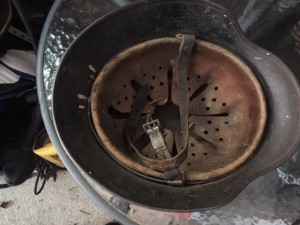
Luftwaffe helmets
Luftwaffe helmets refer to the helmets worn by members of the German Air Force (Luftwaffe) during World War II. Here are some key points about Luftwaffe helmets:
1. Design: Luftwaffe helmets were based on the standard German helmet design used by the army (Heer) but with specific modifications. They featured a rounded crown and flared rim, similar to other German helmets of the era. The helmets were made of steel and had a matte or textured finish.
2. Decals: Luftwaffe helmets typically had decals on both sides, representing the Luftwaffe eagle and swastika emblem on the right side and the national tricolor shield on the left side. These decals were applied during the manufacturing process and were used to identify the branch of service.
3. Liner system: Luftwaffe helmets were equipped with a leather liner system for comfort and fit. The liner included leather straps and pads to secure the helmet on the wearer’s head. The liners were often marked with the size and manufacturer’s information.
4. Variations: Luftwaffe helmets went through several design variations during the war. The early models, such as the M35 and M40, had a smooth finish, while later models, such as the M42, had a rougher, textured finish. Some helmets also featured additional accessories like chinstraps and netting.
5. Collectibility: Luftwaffe helmets are highly sought after by collectors due to their historical significance. However, it is important to be cautious of reproductions and fakes, as they can be prevalent in the market. Authenticating the helmet’s origin, condition, and markings is crucial when purchasing or evaluating a Luftwaffe helmet.
If you are interested in Luftwaffe helmets or any other World War II military artifacts, it is recommended to consult with reputable collectors, historians, or experts in militaria to ensure you have accurate information and make informed decisions.
